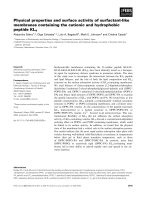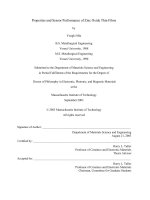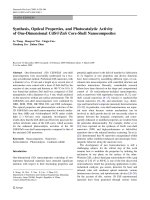Organoleptic acceptability, nutritional properties and shelf life of oat based gluten free instant idli
Bạn đang xem bản rút gọn của tài liệu. Xem và tải ngay bản đầy đủ của tài liệu tại đây (380.11 KB, 11 trang )
Int.J.Curr.Microbiol.App.Sci (2018) 7(3): 1777-1787
International Journal of Current Microbiology and Applied Sciences
ISSN: 2319-7706 Volume 7 Number 03 (2018)
Journal homepage:
Original Research Article
/>
Organoleptic Acceptability, Nutritional Properties and Shelf Life of
Oat Based Gluten Free Instant idli
Bhawna Mehta* and Sudesh Jood
Department of Foods and Nutrition, College of Home-Science, CCS Haryana Agriculture
University, Hisar, Haryana, India
*Corresponding author
ABSTRACT
Keywords
Instant mixes,
Organoleptic
acceptability, Nutritional
properties, Shelf life, Fat
acidity
Article Info
Accepted:
16 February 2018
Available Online:
10 March 2018
Instant mixes are commercially prepared mixture of dry ingredients as these are easy and
fast to prepare. Keeping these facts in view, in the present study five types of gluten free
instant idli were prepared by using instant mixes i.e., 40 per cent rice flour, 20 per cent
mung bean flour and 5 per cent linseed powder in 60 per cent processed (malted, roasted,
popped and flaked) and unprocessed oat flour. It was found that idli prepared from Type-I
(unprocessed oat flour based blend), Type-II (malted oat flour based blend) and Type-III
(flaked oat flour based blend) instant mixes fell in the category of „liked moderately‟
whereas idli prepared from Type-IV and Type-V instant mixes were found in the category
of „liked slightly‟ to „neither liked nor disliked‟. The most acceptable idli was selected for
their nutritional composition and shelf life. Water and oil absorption capacity was
significantly higher in Type-II idli as compared to Type-III and Type-I idli. Whereas,
Type-I dhokla exhibited higher bulk density. Nutritional properties showed that Type-II
(malted oat flour based blend) idli had maximum protein (18.86%), carbohydrates
(68.21%) and energy (389.95 Kcal/100g). Whereas, highest crude fibre (7.22%), ash
(2.38%) and fat (5.33%) content was found in Type-I idli. Storage studies showed that all
the three types of idli prepared from 3 months stored instant mixes were found in the
category of „liked moderately‟ to „liked slightly‟ and acceptable up to 90 days of storage.
Fat acidity content of all three types of idli was found within the permissible limit. It may
be concluded that instant idli mixes could be stored up to 3 months successfully without
any significant change in their sensory attributes.
Introduction
Celiac disease is an autoimmune inflammatory
disease of the small intestine that can occur in
genetically predisposed people due to
ingestion of gluten (a protein found in wheat,
rye and barley (Zannini et al., 2012) which
leads to damage in the small intestine villi
(small finger like projections). The function of
intestinal villi is to promote the nutrient
absorption, as the villi get damaged, nutrients
cannot be absorbed properly in the body
leading to malabsorption of several important
nutrients such as iron, folic acid and calcium,
fat soluble vitamins and many other
manifestations (Jnawali et al., 2016; Tanwar
and Dhillon, 2017). Till date the only
treatment of people suffering from celiac
1777
Int.J.Curr.Microbiol.App.Sci (2018) 7(3): 1777-1787
disease is to follow a gluten free diet (RubioTapia et al., 2013). Complete avoidance of
gluten enables the intestine to heal, and the
nutritional deficiencies and other symptoms to
resolve (Dhankar, 2013). A strict adherence to
gluten-free diet al.,so reduces the risk of
developing many of the serious long-term
complications related to untreated celiac
disease.
However, following a gluten free diet might
sound simple but it is not easy, as it not only
involves eliminating gluten containing grains
and all products that contain them, which
requires constant vigilance, but there is also a
sense of social isolation and pressure that
accompanies the process (Bauman et al.,
2008).
The first consideration in the preparation of
gluten free product includes the exclusion of
any food or food ingredient that contains
gluten, as celiac disease is triggered by the
ingestion of gluten or its protein fraction. Oat
is the only cereal containing a globulin or
legume like protein avenalins, as the major
(80%) storage proteins. It is currently a very
popular coarse cereal in consumer demand due
to its unique nutritional and health properties
(Sharma et al., 2010).
They are generally consumed as whole grains
and hence the nutrients present are not lost
during processing. They are excellent source
of different dietary fibre compound of mixed
linkage (1→3), (1→4) β-D glucan,
arabinoxylans
and
cellulose.
The
incorporation of oats into a gluten free diet
diversifies the celiac diet and also provides
many health and nutritional benefits (Sharma
and Chawla, 2012).
Keeping these facts in view, in the present
study five types of oat based value added
gluten free instant idli were prepared by using
unprocessed and processed instant mixes.
Materials and Methods
Procurement of selected oat variety
One oat variety (OS-346) was procured from
the Forage Section of the Department of
Genetics and Plant Breeding, CCS Haryana
Agricultural University, Hisar, whereas rice,
mung bean and linseed samples were
purchased from local market.
All the samples were cleaned and stored in
plastic containers till further use. The oat grain
samples were processed by using various
processing techniques.
Processing of oat grains
Different processing methods were used to
process the oat grains:
The unprocessed and processed oat grains,
rice and mung bean were subjected to milling
to obtain flour. Linseed seeds were roasted
and ground to obtain fine powder. Roasted oat
flour, rice flour, mung bean flour and linseed
powder separately in ratio of 60:40:20:5 and
then roasted spices (mustard seeds and curry
leaves). Added sodium bicarbonate, citric
acid, Eno and salt and mixed all the
ingredients well. Then packed and sealed in
polyethylene pouches.
Reconstituted idli mix (100g) with curd (80g)
and water (30g) then mix it properly to form a
smooth batter. Poured the mixture in greased
moulds and microwave for 2-3 minutes.
Organoleptic evaluation of oat based gluten
free instant Idli
Instant idli were subjected to sensory
evaluation with respect to color, appearance,
aroma, texture, taste and overall acceptability
by a panel of 10 semi trained judges, using 9
point hedonic scale.
1778
Int.J.Curr.Microbiol.App.Sci (2018) 7(3): 1777-1787
Functional and nutritional properties of oat
based gluten free instant Idli
taste and overall acceptability using a ninepoint Hedonic Scale.
On the basis of organoleptic acceptability
instant idli prepared with unprocessed, malted
and flaked oat flour based mix were selected
for further nutritional analysis. Water
absorption capacity of flours was measured by
the method described by Singh and Singh
(1991). Oil absorption capacity was done
according to the method of Iyer and Singh
(1997). For measuring the bulk density, grains
were gently filled in a 100 ml graduated
cylinder. The bottom of cylinder was gently
tapped several times until there was no further
diminution of the sample level either filling to
the 100 ml mark. Bulk density was calculated
as weight of sample per unit volume of sample
(g/100 ml). The different protein fractions
viz., albumin (water soluble), globulin (salt
soluble), prolamin (alcohol soluble) and
glutelin (alkali soluble) were determined
according to the method of AACC (2000).
Proximate composition such as moisture,
protein, crude fat, crude fibre and ash was
determined by employing the standard method
of
analysis
(AOAC,
2000).
Total
carbohydrates were estimated by the following
calculation method: Total carbohydrates (%) =
100 – (Crude protein+crude fat+crude
fibre+ash). Total energy was calculated
theoretically by using the following
conversion factors 4.0, 4.0 and 9.0 Kcal/ g for
protein, carbohydrates and fat, respectively,
according to the method described by Paul and
Southgate (1979) (Table 4).
Fat acidity
Shelf life of most acceptable developed oat
based gluten free instant idli
Sensory evaluation
Organoleptic evaluation of stored products
were done for period of 3 months at interval of
one month by a panel of ten semi trained
judges for colour, appearance, aroma, texture,
The fat acidity was determined by the standard
method of analysis (AOAC, 2000).
Statistical analysis
Mean, standard error and CD (critical
difference) were calculated for analysis of data
(Sheoran and Pannu, 1999).
Results and Discussion
Five types of idli developed from instant idli
mixes which were prepared by addition of 40
per cent rice flour, 20 per cent mung bean
flour and 5 per cent linseed powder in 60 per
cent unprocessed and processed oat flour. The
data on organoleptic acceptability of oat based
gluten free instant idli is presented in Table 1.
Mean scores of colour of five types of idli
ranged from 5.25 to 7.60, respectively. Idli
prepared from (Type-I, Type-II, Type-III and
Type-IV) instant mixes based on unprocessed,
malted, flaked and roasted oat flour fell in the
category of „liked moderately‟. Whereas idli
prepared from (Type-V) instant mix based on
popped oat flour got lowest scores of colour
i.e. 5.25 which was „liked slightly‟ by the
penalists. Mean scores of appearance of all
five types of idli were 7.72, 7.78, 7.58, 6.99
and 5.90 respectively, with idli prepared from
Type-I, Type-II and Type-III instant mixes
based on unprocessed, malted and flaked oat
flour were found in the category of „liked
moderately‟. However, idli which prepared
from instant mixes based on (Type-IV and
Type-V) roasted and popped oat flour was
found to be in the category of „liked slightly‟
to „neither liked nor disliked‟. Aroma scores
of (Type-I, Type-II and Type-III) idli prepared
from instant mixes based on unprocessed,
malted and flaked oat flour were 7.18, 7.58
1779
Int.J.Curr.Microbiol.App.Sci (2018) 7(3): 1777-1787
and 7.27, which were „liked moderately‟ by
the panelists. However, 6.90 and 6.59 aroma
scores were obtained by Type-IV and Type-V
idli which was „liked slightly‟ by the judges.
Type-IV
and
Type-V
Idli
differed
significantly from other three types of idli.
Texture scores of Type-I, Type-II, Type-III
and Type-IV idli (mixes based on
unprocessed, malted, flaked and roasted oat
flour) were fell in the category of „liked
moderately‟. Whereas the texture of idli
prepared with popped oat flour (Type-V)
based instant mix (6.60) was „liked slightly‟
by the judges. It may be due to the fact that
popping of oat grains imparts dryness to the
idli. Taste scores of idli prepared from mixes
using unprocessed, malted and flaked oat flour
(Type-I, Type-II and Type-III) were 7.25, 7.29
and 7.48, respectively, which found in the
category of „liked moderately‟. However, the
taste of roasted and popped oat flour based idli
(Type-IV and Type-V) was found in the
category of „liked slightly‟ to „neither liked
nor disliked‟. Overall acceptability scores of
all types of idli ranged from 5.95 to 7.53,
being highest (7.53) in Type-II idli (malted oat
flour based mix) and lowest (5.95) in Type-V
idli (popped oat flour based mix).. Overall
acceptability scores of idli made from mixes
based on unprocessed, malted and flaked oat
flour (Type-I, Type-II and Type-III) were
found in the category of „liked moderately‟
whereas idli made from roasted and popped
oat flour (Type-IV and Type-V) based mixes
were „liked slightly‟ and „neither liked nor
disliked‟ by the panelists. Sharma et al.,
(2010) also reported that supplementation with
roasted oat flour resulted in decreased sensory
scores of idli due to development of dark
colour, burnt flavour and taste which are in
close agreement with the present results.
Water absorption capacity of idli prepared
from Type-I instant mix (based on
unprocessed oat flour) was 2.17 g/g, which
increased significantly (P ≤ 0.05) in idli
prepared from Type-II mix (based on malted
oat flour). Whereas, the idli prepared from
Type-III mix (based on flaked oat flour) had
almost similar (2.18 g/g) water absorption
capacity as in idli prepared from Type-I mix.
Non-significant differences were found
between the water absorption capacity of idli
prepared from Type-I and Type-III mixes.
These results are in accordance with Murugkar
et al., (2013) who reported that water
absorption index and water solubility index
increased significantly in germinated mixes
indicating the ability of flour to absorb more
water. Other workers also reported similar
results which are in close agreement with the
present results (Ocheme and Chinma 2008;
Gernah et al., 2011; Ocheme et al., 2015). Oil
absorption capacity of all three types of idli
was 1.89, 1.93 and 1.90 g/g, respectively.
Highest (1.93 g/g) was observed in Type-II
idli followed by Type-III and Type-I idli
prepared from three different instant mixes.
Deepali et al., (2013) reported that
germination promote/induced oil absorption
capacity may be due to solubilization and
dissociation of proteins leading to exposure of
non-polar constituents from within the protein
molecule (Table 2). Ocheme and Chinma
(2008); Gernah et al., (2011); Ocheme et al.,
(2015) also reported similar results which are
in agreement of present study. Bulk density
was 0.67 g/ml in idli prepared from Type-I
mix (based on unprocessed oat flour), which
declined in idli prepared from Type-II and III
mix (based on malted and flaked oat flour).
The bulk density was almost similar in Type-I
and Type-III idli. The values were 0.67 and
0.68 g/ml respectively. The bulk density of
idli prepared from Type-I mix differed
significantly from idli prepared from Type-II
mix. Other workers (Elkhalifa and Bernhardt
2010; Onesmo 2011; Imtiaz and Burhan 2012)
also reported that bulk density of products
made from malted and flaked millet/pulses
flour mixes had lower bulk density than
products made from unprocessed millet/pulses
mixes.
1780
Int.J.Curr.Microbiol.App.Sci (2018) 7(3): 1777-1787
Table.1 Mean scores of organoleptic acceptability of oat based gluten free instant idli
Instant Idli
Colour
Appearance
Aroma
Type-I
Type-II
Type-III
Type-IV
Type-V
CD (P≤0.05)
7.60±0.23
7.61±0.23
7.33±0.14
7.13±0.13
5.25±0.58
0.94
7.72±0.29
7.78±0.21
7.58±0.19
6.99±0.28
5.90±0.52
0.93
7.18±0.21
7.58±0.23
7.27±0.11
6.90±0.14
6.59±0.14
0.49
Texture
7.36±0.18
7.41±0.16
7.38±0.13
7.00±0.00
6.60±0.22
0.46
Taste
Overall Acceptability
7.25±0.22
7.29±0.12
7.48±0.16
6.80±0.21
5.45±0.38
0.68
7.42±0.15
7.53±0.12
7.40±0.08
6.96±0.07
5.95±0.17
0.39
Values are mean ± SE of ten independent determinations
Type-I: Unprocessed oat flour: Rice flour: Mung bean flour: Linseed powder (60:40:20:5)
Type-II: Malted oat flour: Rice flour: Mung bean flour: Linseed powder (60:40:20:5)
Type-III: Roasted oat flour: Rice flour: Mung bean flour: Linseed powder (60:40:20:5)
Type-IV: Popped oat flour: Rice flour: Mung bean flour: Linseed powder (60:40:20:5)
Type-V: Flaked oat flour: Rice flour: Mung bean flour: Linseed powder (60:40:20:5)
Table.2 Physico-chemical properties of oat based gluten free instant idli (on dry matter basis)
Instant idli
Type-I
Type-II
Type-III
CD(P≤0.05)
Water absorption
Capacity (g/g)
2.17±0.02
2.20±0.01
2.18±0.05
0.02
Oil absorption
Capacity (g/g)
1.89±0.01
1.93±0.00
1.90±0.02
0.03
Bulk
Density (g/ml)
0.67± 0.01
0.62±0.02
0.68±0.00
0.04
Gluten
(g/100g)
ND
ND
ND
-
Values are mean ± SE of three independent determinations
ND=Not detected
Type-I: Unprocessed oat flour: Rice flour: Mung bean flour: Linseed powder (60:40:20:5)
Type-II: Malted oat flour: Rice flour: Mung bean flour: Linseed powder (60:40:20:5)
Type-III: Flaked oat flour: Rice flour: Mung bean flour: Linseed powder (60:40:20:5)
Table.3 Protein fractions (%) of oat based gluten free instant idli (on dry matter basis)
Instant idli
Albumin
Globulin
Prolamin
2.87±0.02
5.45±0.18
1.12±0.01
Type-I
3.73±0.01
6.78±0.21
0.92±0.03
Type-II
3.60±0.03
6.32±0.15
0.99±0.03
Type-III
0.04
0.12
0.03
CD(P≤0.05)
Values are mean ± SE of three independent determinations
Type-I: Unprocessed oat flour: Rice flour: Mung bean flour: Linseed powder (60:40:20:5)
Type-II: Malted oat flour: Rice flour: Mung bean flour: Linseed powder (60:40:20:5)
Type-II : Flaked oat flour: Rice flour: Mung bean flour: Linseed powder (60:40:20:5)
Glutelin
3.22± 0.02
3.47±0.06
3.33±0.01
0.06
Table.4 Proximate composition (%) and energy (Kcal/100g) of oat based gluten free instant idli
(on dry matter basis)
Instant
idli
Moisture
Crude
protein
Crude
fibre
Ash
Crude
fat
Carbohydrates
Energy
Type-I
Type-II
Type-III
CD(P≤0.05)
5.45±0.11
6.73± 0.14
6.39±0.06
0.61
18.48±0.52
18.86±0.61
18.61±0.45
NS
7.22±0.17
6.28±0.17
6.31±0.21
0.56
2.38±0.09
2.21±0.03
2.02±0.01
0.11
5.33±0.05
4.63±0.09
4.68±0.01
0.28
66.59± 1.66
68.21± 1.87
68.19± 1.68
0.92
388.00±2.81
390.00±3.46
389.00±2.99
0.74
Values are mean ± SE of three independent determinations
NS=Non-significant
Type-I: Unprocessed oat flour: Rice flour: Mung bean flour: Linseed powder (60:40:20:5)
Type-II: Malted oat flour: Rice flour: Mung bean flour: Linseed powder (60:40:20:5)
Type-III: Flaked oat flour: Rice flour: Mung bean flour: Linseed powder (60:40:20:5)
1781
Int.J.Curr.Microbiol.App.Sci (2018) 7(3): 1777-1787
Table.5 Effect of storage period on organoleptic characteristics of oat based
gluten free instant idli mixes
Organoleptic characteristics
Mean
Type-I
7.60±0.23
7.40±0.14
7.35±0.15
7.00 ±0.00
7.33
Storage period=N.S Treatments= N.S
7.72±0.29
7.35±0.16
7.15±0.10
7.00±0.14
7.30
Storage period=N.S Treatments= N.S
7.58±0.23
7.25±0.13
7.00±0.14
6.25±0.13
7.02
Storage period=N.S Treatments= N.S
7.36±0.18
7.00±0.14
6.50±0.16
6.10±0.10
6.74
Storage period=N.S Treatments= N.S
7.25±0.22
7.20±0.13
7.10±0.10
7.00±0.14
7.15
Storage period=0.65 Treatments= N.S
7.50±0.12
7.24±0.05
7.02±0.06
6.67±0.04
7.11
Type-II
7.61±0.23
7.30±0.15
7.25±0.13
6.80±0.13
7.24
Interaction=N.S
7.78±0.21
7.40±0.16
7.30±0.21
7.00±0.00
7.37
Interaction= 1.39
7.18±0.21
7.05±0.05
6.80±0.20
6.00±0.00
6.75
Interaction=N.S
7.41±0.16
7.00±0.00
6.20±0.13
6.00±0.00
6.65
Interaction=1.35
7.29±0.12
7.20±0.13
7.00±0.10
6.90±0.15
7.09
Interaction=N.S
7.45±0.09
7.19±0.06
6.91±0.08
6.54±0.03
7.00
CD (P<0.05)
Storage period=0.72 Treatments =0.83
Interaction= 1.44
Colour
Storage period (Days)
0
30
60
90
Mean
CD (P≤0.05)
Appearence
0
30
60
90
Mean
CD (P≤0.05)
Aroma
0
30
60
90
Mean
CD (P≤0.05)
Texture
0
30
60
90
Mean
CD (P≤0.05)
Taste
0
30
60
90
Mean
CD (P≤0.05)
Overall acceptability
0
30
60
90
Type-III
7.33±0.14
7.15±0.13
6.90±0.10
6.50±0.16
6.97
7.58±0.19
7.20±0.13
7.00±0.14
6.80±0.13
7.14
7.27±0.11
7.00±0.00
6.95±0.05
6.00±0.00
6.80
7.48±0.16
7.00±0.21
6.10±0.10
6.00±0.00
6.64
7.48±0.13
7.25±0.13
6.80±0.13
6.70±0.16
7.05
7.40±0.08
7.12±0.04
6.75±0.05
6.40±0.05
6.90
Values are mean ±S.E of ten independent determinations
Type-I: Unprocessed oat flour: Rice flour: Mung bean flour: Linseed powder (60:40:20:5)
Type-II: Malted oat flour: Rice flour: Mung bean flour: Linseed powder (60:40:20:5)
Type-III: Flaked oat flour: Rice flour: Mung bean flour: Linseed powder (60:40:20:5)
Table.6 Effect of storage on fat acidity (mg KOH/100g) of oat based gluten
free instant idli (dry matter basis)
Instant idli
Storage Period (Days)
30
60
90
Type-I
30.40±0.22
39.60±0.26
46.41±0.20
Type-II
31.92±0.53
40.52±0.36
47.54±0.35
Type-III
31.46±0.38
40.03±0.30
47.11±0.66
Storage period =10.53 Treatments= 9.12 Interaction=N.S
CD (P≤0.05)
Values are mean ± SE of ten independent determinations
Type-I: Unprocessed oat flour: Rice flour: Mung bean flour: Linseed powder (60:40:20:5)
Type-II: Malted oat flour: Rice flour: Mung bean flour: Linseed powder (60:40:20:5)
Type-III: Flaked oat flour: Rice flour: Mung bean flour: Linseed powder (60:40:20:5)
0
21.68±0.64
22.54±0.28
22.28±0.24
1782
Int.J.Curr.Microbiol.App.Sci (2018) 7(3): 1777-1787
Oat grains
PreparationCleaning
of instant idli mix
Overnight soaking (oat: water:: 1:3)
Germination (for 48 h)
Drying in hot air oven(60o C for 6 hrs)
Removal of root-lets by hand braising
Ground to fine powder
Stored in air tight containers
Oat grains
Cleaning
Roasting in a karahi till light brown
Cooling
Ground to fine powder
Stored in air tight containers
Fig. 3.1: Flow diagram for malting
process
Fig. 3.2: Flow diagram for roasting
process
Oat grains
Cleaning
Soaking overnight
Pressure cooking for 20 min.
Pressing with rollers
Drying in hot air oven at 60o C
Ground to fine powder
Stored in air tight containers
Oat grains
Cleaning
Soaking overnight
Drying at room temperature
(in open for 12 h)
Puffing in traditional furnace using sand
(at 200-250oC)
Cooling
Ground to fine powder
Stored in air tight containers
Fig. 3.4: Flow diagram for flaking
process
Fig. 3.3: Flow diagram for popping
process
1783
Int.J.Curr.Microbiol.App.Sci (2018) 7(3): 1777-1787
It might be due to breakdown of complex
compounds such as starch and proteins
(Ocheme et al., 2015; Takhellambam and
Chimmad 2015). Gluten content was not
found in any of three instant idli.
Albumin content was 2.87 per cent in idli
which made from Type-I mix and it increased
gradually in idli which prepared from Type-II
and Type-III mix. Type-II idli had
significantly (P≤0.05) higher (3.73%)
albumin content followed by Type-III
(3.63%) and Type-I (2.87%) idli. Globulin
contents ranged from 5.45 to 6.78 per cent,
respectively which were found highest
(6.78%) in idli which prepared from Type-II
mix (malted oat flour based mix) and lowest
(5.45%) in Type-I idli (unprocessed oat flour
based mix) (Table 3).
Prolamin content was significantly (P≤0.05)
lowest in Type-II and Type-III idli (malted
and flaked oat flour based mix) as compared
to Type-I idli (unprocessed oat flour based
mix). On mean basis, the prolamin content
was found highest (1.12%) in Type-I idli
followed by Type-III (0.99%) and lowest
(0.92%) in Type-II idli.
Glutelin content was 3.22 per cent in idli
which prepared from mix based on
unprocessed (Type-I) oat flour which
increased significantly (P≤0.05) with the use
of malting and flaking processing methods.
Idli which prepared from mixes based on
malted (Type-2) oat flour had highest (3.47%)
content of glutelin content followed by flaked
(Type-III 3.33%) and unprocessed (Type-I
3.22%) oat flour. Other workers also reported
similar results (Wu 1983; Moneim et al.,
2012; Rasane et al., 2015) which are in
agreement with the present results.
Moisture content of all the three types of idli
ranged from 5.45 to 6.73 per cent,
respectively, being highest (6.73%) in Type-II
idli (malted oat flour based mix) and lowest in
Type-I idli (unprocessed oat flour based mix).
Protein content of all the three types of idli
were 18.48, 18.86 and 18.61 per cent,
respectively. Protein content was nonsignificantly increased by use of malted and
flaked oat flour. Among them, Type-II idli
(malted oat flour based mix) had nonsignificantly (P≤0.05) higher (18.86%)
protein content followed by 18.61 per cent in
Type-III idli (flaked oat flour based mix) and
18.48 per cent in Type-I idli (unprocessed oat
flour based mix). Crude fibre content of all
the three types of idli varied from 6.28 to 7.22
per cent, respectively, with the highest
(7.22%) in Type-I idli and lowest (6.28%) in
Type-II idli. Type-II and Type-III idli differed
non-significantly from each other (P≤0.05).
Ash content of all the three types of idli
ranged from 2.02 to 2.38 per cent,
respectively. Ash content of all three types of
idli differed significantly (P≤0.05). Crude fat
content ranged from 4.63 to 5.33 per cent,
respectively in three types of idli made from
processed (malted and flaked oat flour based
mixes) and unprocessed oat flour based
mixes. Maximum was observed in Type-I idli
and minimum in Type-II idli. Non-significant
difference was observed in Type-II and III
idli. Similar results were also reported by
other workers in products made from malted
and unprocessed mixes (Kaushik et al., 2010;
Murugkar et al., 2013; Tiwari and Awasthi
2014; Gupta and Brar 2015) who reported that
sprouted mixes had significantly higher
amount of protein but lower amount of crude
fat, crude fibre and ash contents as compared
to unprocessed mixes. Giridhar and Sathisha
(2016) also reported that there was significant
decrease in protein, crude fibre and fat
content after flaking of millet grains which
are similar as reported in flaked products in
the present study. Carbohydrate content of all
the three types of idli ranged from 66.59 to
68.21 per cent, respectively. Non-significant
difference was observed in carbohydrate
1784
Int.J.Curr.Microbiol.App.Sci (2018) 7(3): 1777-1787
content of Type-II and Type-III idli. Energy
content ranged from 388 to 390 Kcal/100g,
respectively in all the three types of idli.
Similar results were also reported by earlier
workers (Urbano et al., 2005; Laxmi et al.,
2015) in processed and unprocessed instant
mixes/products.
Shelf life of most acceptable developed
value added gluten free products
Organoleptic evaluation and fat acidity
Stored products were studied for their sensory
characteristics at an interval of 30 days upto
acceptability by a panel of 10 semi-trained
judges using nine-point Hedonic Scale (Table
5). Three types of idli prepared using fresh (0
day) and stored instant idli mixes (Type-I,
Type-II and Type-III) (based on unprocessed
and processed (malted and flaked) oat flour)
were organoleptically evaluated. Mean scores
of colour of idli prepared from fresh (0 day)
three types of idli mixes were 7.60, 7.61 and
7.33 respectively, which fell in the category
of „liked moderately‟. These scores decreased
non-significantly with increase in storage
intervals i.e 30, 60 and 90 days, which found
in the category of „liked moderately‟ to „liked
slightly‟. Similarly, mean scores of
appearance of idli prepared from fresh (0 day)
three types of idli mixes were were 7.72, 7.78
and 7.58 which were „liked moderately‟ by
the panelists. These scores declined as on
increasing the storage period up to 3 months
and found in the category of „liked
moderately‟ up to 60 days. However, on 90
days of storage, the appearance of idli
prepared from 90 days stored three types of
idli mixes were found in the category of
„liked moderately‟ to „liked slightly‟. Aroma
scores of all the three types of idlis developed
from fresh (0 day) and 30th day stored idli
mixes were „liked moderately‟ by the judges.
However, the aroma of idli developed from
60 days stored Type-I mix (unprocessed oat
flour based mix) fell in the category of „liked
moderately‟ and idli prepared from 60 days
stored Type-II and Type-III idli mixes were
„liked slightly‟. The obtained mean scores
were 7.00, 6.80 and 6.95, respectively.
Whereas, the aroma of all the three types of
idlis were „liked slightly‟ on 90th day of
storage. Similarly, the texture scores of three
types of idli prepared from fresh (0 day) and
30 days stored idli mixes were „liked
moderately‟ by the panelists. Whereas, mean
scores of texture of idli prepared from 60 and
90 days stored all the three types of idli mixes
were „liked slightly‟ by the judges. Taste
scores of idli prepared from fresh (0 day) and
30 days stored three types of idli mixes were
found in the category of „liked moderately‟
However, the taste scores of idli prepared
from 60 and 90 days stored idli mixes were
found in the category of „liked moderately‟ to
„liked slightly‟.
Overall acceptability mean scores of idli
prepared from fresh (0 day) Type-I, Type-II
and Type-III idli mixes were 7.50, 7.45 and
7.40,
respectively
which
decreased
significantly with increase in storage period
i.e., 30, 60 and 90 days. However, overall
acceptability scores of idli prepared from
stored Type-I (7.67) Type-II (6.54) and TypeIII (6.40) idli mixes were still found in the
acceptable category even up to 90 days of
storage, might be due to low moisture content.
Fat acidity content of idli prepared from fresh
(0 day) stored idli mix (Type-I) had 21.68 mg
KOH/100g. Whereas, 22.54 and 22.28 mg
KOH/100g were found in idli prepared from
fresh (0 day) stored Type-II and Type-III idli
mixes. These were found to be increased with
increase in storage interval. The values were
30.40, 39.60 and 46.41 mg KOH/100g in idli
prepared from 30, 60 and 90 days stored idli
mixes. Whereas, fat acidity content i.e 31.92,
40.52 and 47.54 mg KOH/100g in idli
prepared from 30, 60 and 90 days stored
Type-II idli mix and 31.46, 40.03 and 47.11
1785
Int.J.Curr.Microbiol.App.Sci (2018) 7(3): 1777-1787
mg KOH/100g in idli prepared from 30, 60
and 90 days stored Type-III idli mix,
respectively. All these values were found
within the permissible limit (Table 6).
From the present study it can be concluded
that there is great scope for utilization of
unprocessed and processed (malted and flaked
oat flour based mix) oat flour to develop
value added gluten free instant idli mix for
celiac disease patients having good shelf life.
References
A.A.C.C. 2000. Approved Methods of
Analysis. The American Association of
Cereal Chemists, St. Paul, MN.
A.O.A.C. 2000. Approved Methods of
Analysis. 16th Ed. Association of
Official
Analytical
Chemists.
Arlyngton, Verginia, USA.
Bauman, E., J. Friedlander, Gluten sensitivity:
a
rising
concern,
2008. />c/download?doi=10.1.1.698.9621&rep
=rep1&type=pdf (accessed 16.08.03).
Dhankar, P. 2013. A study on development of
coconut based gluten-free cookies.
International Journal of Engineering
Science Invention. 2(12): 1–9.
Elkhalifa, A.E.O. and Bernhardt, R. 2010.
Influence of grain germination on
functional properties of sorghum flour.
Food Chemistry. 121: 387-392.
Gernah, D. I., Ariahu, C. C. and Ingbian, E.
K. 2011. Effects of malting and lactic
fermentation on some chemical and
functional properties of maize (Zea
mays). American Journal of Food
Technology, 6:404-412.
Giridhar, G. and Sathisha, G.J. 2016. Effect of
extrusion and flaking on the retention of
nutrients and phenolic compounds in
millet grains. International Journal of
Food Science and Nutrition. 1(4): 0811.
Gupta, S. and Brar, J. 2015. Formulation and
evaluation of malted ingredient mixes.
International Journal of Food and
Nutrition Sciences. 5(3): 182-90.
Imitiaz, H. and Burhan, U.M. 2012.
Optimization effect of germination on
functional properties of wheat flour by
response
surface
methodology.
International Research Journal of Plant
Science. 3(3): 31-37.
Iyer, L. and Singh, U. 1997. Functional
properties of wheat and chickpea
composite flours. Food Australia.49:
27-31.
Jnawali, P., Kumar, V. and Tanwar, B. 2016
Celiac
disease:
Overview
and
considerations for development of
gluten free foods. Food Science and
Human Wellness. 5: 169–176.
Kaushik, G., Satya, S. and Naik S.N. 2010.
Effect
of
domestic
processing
techniques on the nutritional quality of
the soybean. Mediterranean Journal of
Nutrition and Metabolism. 3(1): 39-46.
Laxmi, G., Chaturvedi, N. and Richa, S. 2015.
The impact of malting on nutritional
composition of foxtail millet, wheat and
chickpea. Journal of Nutrition and Food
Sciences. 5(5): 1-3.
Moneim, A.E., Afify, M.R., El-Beltagi, H.S.,
Samiha, M., Salam, A.E. and Omran,
A.A.
2012.
Protein
solubility,
digestibility and fractionation after
germination of sorghum varieties. Plos
One. 7(2):1-5.
Murugkar, D.A., Gulati, P. and Gupta, C.
2013. Effect of sprouting on physical
properties and functional and nutritional
components of multi-nutrient mixes.
International Journal of Food and
Nutritional Sciences. 2: 8-15.
Ocheme, O. B., Adedeji, O. E., Lawal, G. and
Zakari, U. M. 2015. Effect of
germination on functional properties
and degree of starch gelatinization of
1786
Int.J.Curr.Microbiol.App.Sci (2018) 7(3): 1777-1787
sorghum flour. Journal of Food
Research. 4(2): 159-65.
Ocheme, O.B. and Chinma, C. E. 2008.
Effects of soaking and germination on
some physico-chemical properties of
millet flour for porridge production.
Journal of Food Technology. 6(5): 18518.
Onesmo, N.O. 2011. Effect of malting and
fermentation on the composition and
functionality
of
sorghum
flour.
Dissertation in Food Science &
Technology.
./
foodscidiss/12.
Paul, A. and Southgate, A.D. 1979. The
composition of food. 4th Edition,
Elsevier North, Holland Biomedical
Press, Amestrdam. pp, 5-11.
Rasane, P., Jha, A., Sabikhi, L., Kumar, A.
and
Unnkrishnan,
V.S.
2015.
Nutritional advantages of oats and
opportunities for its processing as value
added foods – a review. Journal of Food
Science and Technology. 52, 662-75.
Rubio-Tapia, A., Hill, I.D., Kelly, C.P.,
Calderwood, A.H. and Murray, J.A.
2013.
ACG
clinical
guidelines:
diagnosis and management of celiac
disease.
American
Journal
of
Gastroenterology. 108: 656–676.
Sharma, V. and Chawla, P. 2012.
Development and nutritive evaluation of
oat supplemented products for celiac
disease. Journal of Dairying Foods and
Home Sciences. 31: 112 – 116.
Sharma, V., Chawla, P. and Grover, K. (2010)
Organoleptic
characteristics
and
nutrient
composition
of
oats
supplemented products. Journal of
How to cite this article:
Research.
Punjab
Agricultural
University. 47: 173-175.
Sheoran, O.P. and Pannu, R.S. 1999.
Statistical package for agricultural
works. “O.P. Stat” Collage of
Agriculture, Kaul, CCS HAU, Hisar.
Singh, U. and Singh, B. 1991.Functional
properties of sorghum-peanut composite
flour. Cereal Chemistry. 68(5): 460463.
Takhellambam, R.D. and Chimmad, B.V.
2015. Study on physico-functional and
nutrient composition of ready-to-cook
(RTC) millet flakes. Asian Journal of
Home Science. 10(2): 327-331.
Tanwar, B. and Dhillon, M. 2017 Preparation
and nutritional quality evaluation of
gluten-free cookies. Asian Journal of
Dairy and Food Research, 36(1): 63-66.
Tiwari, N. and Awasthi, P. 2014. Effect of
different processing techniques on
nutritional characteristics of oat (Avena
sativa) grains and formulated weaning
mixes. Journal of Food Science and
Technology. 51: 2256-2259.
Urbano, G., Lopez, T., Porres, J.M., Gomezvillalvaa, E. and Frias, J. 2005.
Nutritional assessment of raw and
germinated Pea. Scientific Research and
Essays. 9(4), 52-59.
Wu, Y.V. 1983. Effect of germination on oats
and oat protein. Cereal Chemistry.
60(6): 418-420.
Zannini, E., Pontonio, E., Waters, DM. and
Arendt, E.K. 2012. Applications of
microbial fermentations for production
of
gluten-free
products
and
perspectives. Applied Microbiology
Biotechnology, 93: 473-485.
Bhawna Mehta and Sudesh Jood. 2018. Organoleptic Acceptability, Nutritional Properties and
Shelf Life of Oat Based Gluten Free Instant idli. Int.J.Curr.Microbiol.App.Sci. 7(03): 17771787. doi: />
1787
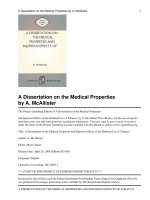
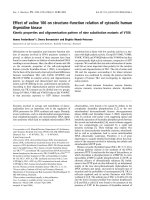
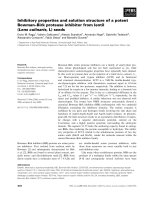
![Báo cáo khoa học: Properties and significance of apoFNR as a second form of air-inactivated [4Fe-4S]ÆFNR of Escherichia coli pot](https://media.store123doc.com/images/document/14/rc/at/medium_ata1395562826.jpg)

